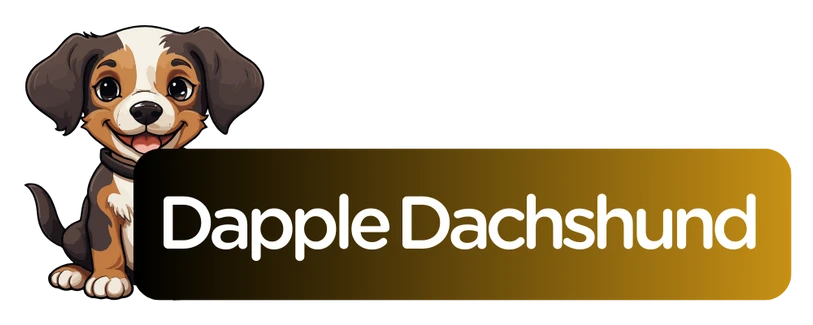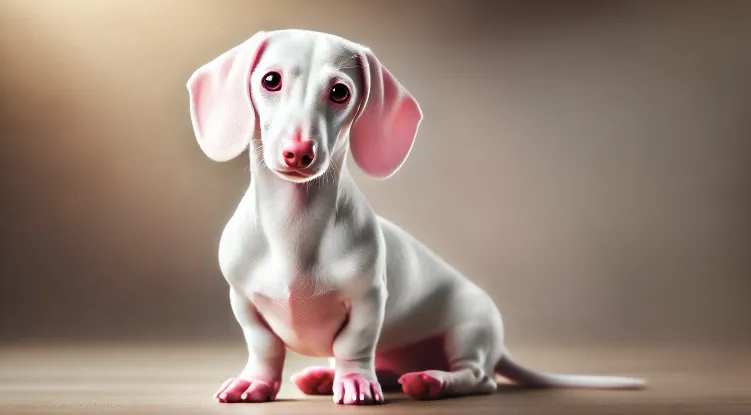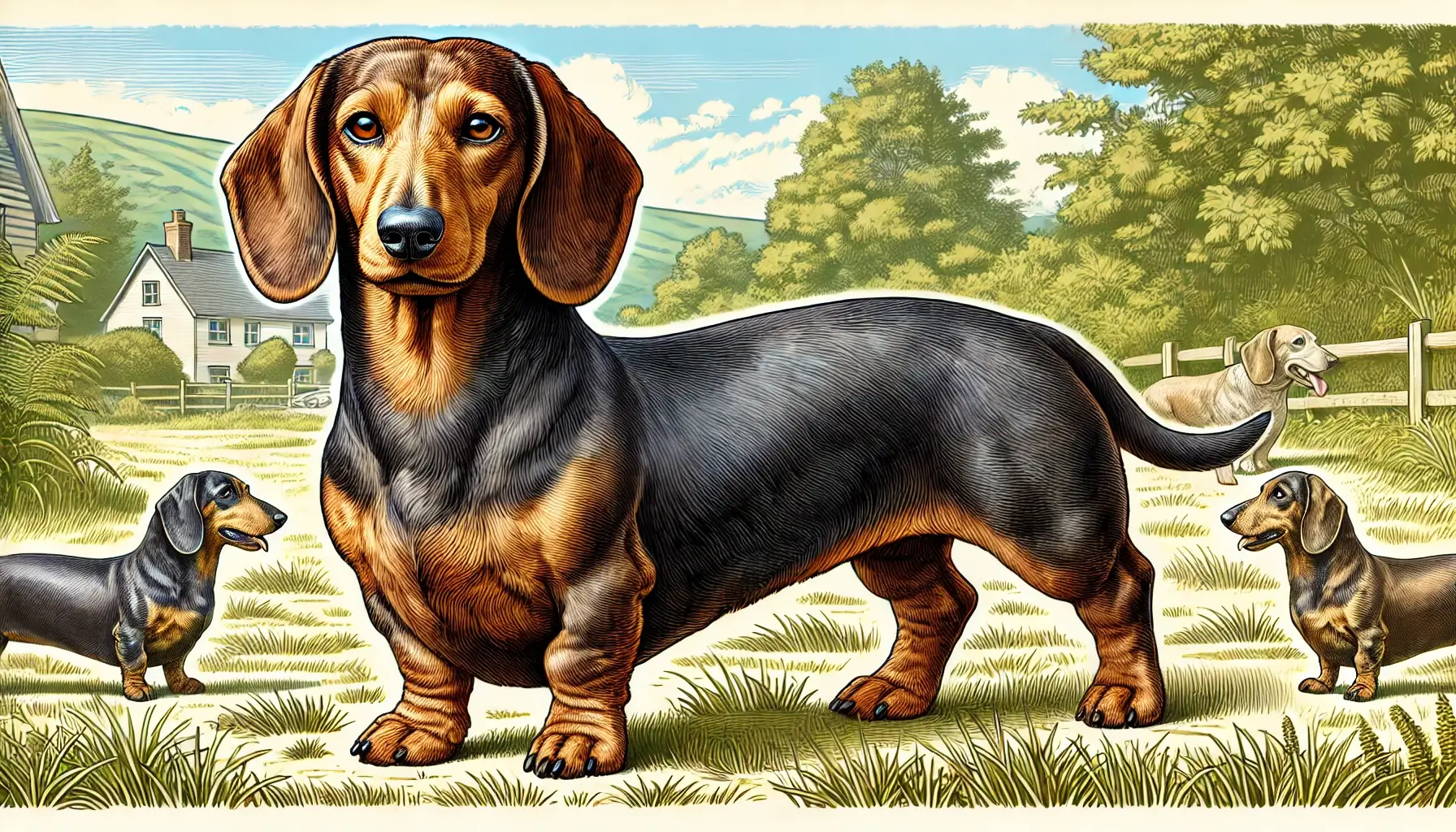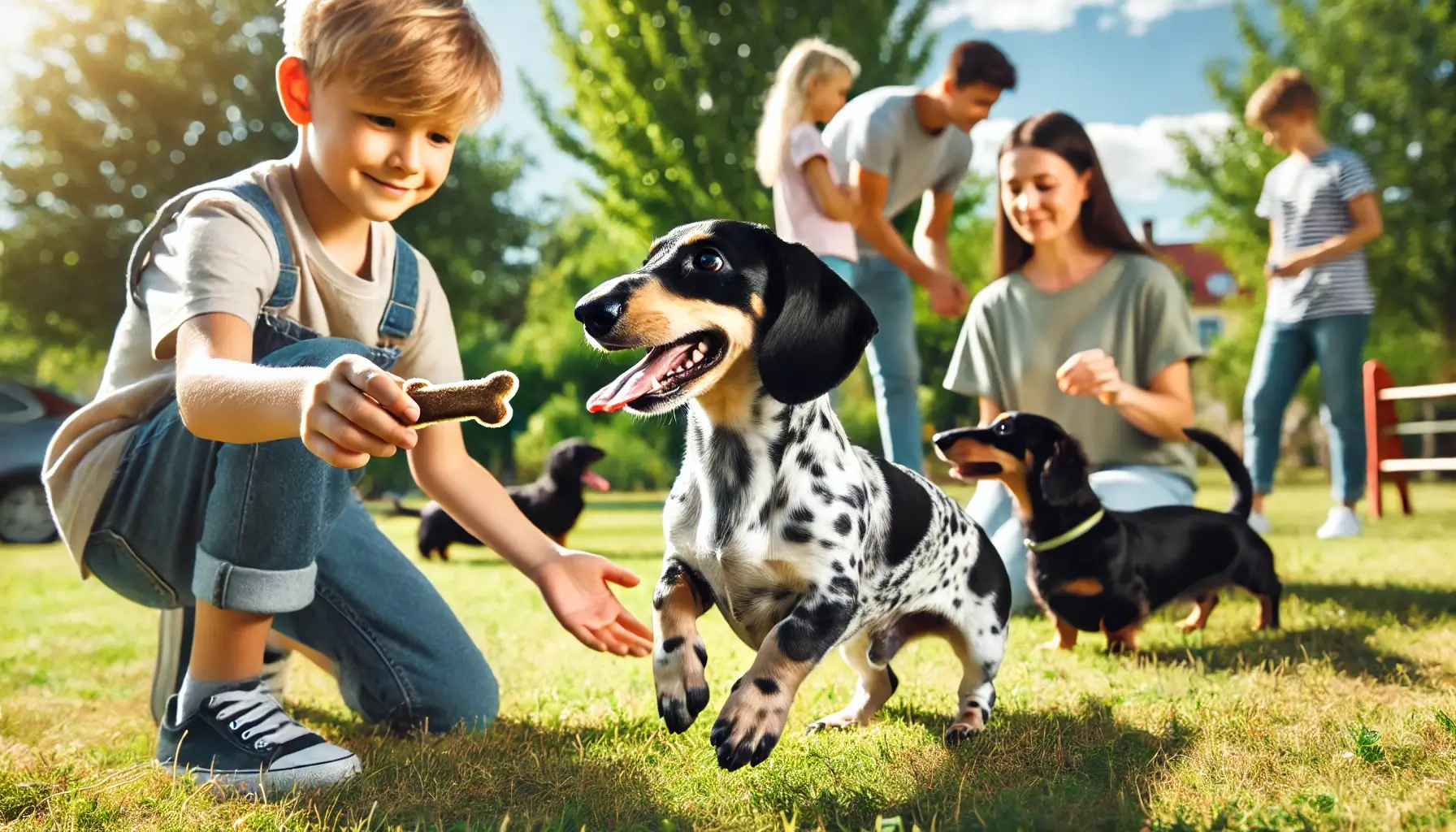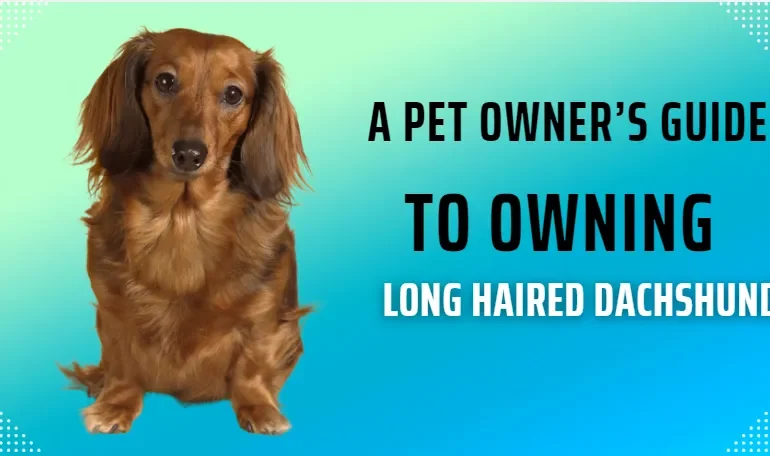
A Pet Owner’s Guide to Owning a Long Haired Dachshund
I gotta be honest with you guys. I was sick last week, and that’s why, I didn’t post anything. I had an eardrum perforation which caused great discomfort and focusing issues.
However, Mondays inspired me to write again, as the first day of the week. So, here I am, writing on Dachshunds again!
One of the most beloved and popular Dachshund breeds, the Long Haired Dachshund are identified as dog with thick coats and long hair covering their whole body.
If you’re thinking of owning a Long haired Dachshund, it’s important to ensure you have the complete information about them. You should know their needs, wants, nutrition guide, grooming, exercise, and training!
In this article, we will go through each aspect of Long haired doxies, so you can make a responsible decision if you are capable of adopting them or not. Let’s start without further ado.
Characteristics Table: Long Haired Dachshund
| Characteristic | Description |
| Physical Measurements | – Height: 5–9 inches (13–23 cm) at the shoulder- Weight: – Standard: 16–32 lbs (7–14.5 kg) – Miniature: Up to 11 lbs (5 kg) |
| Happy Level | Generally cheerful and affectionate, thriving in attentive and loving households. |
| Moodiness | Can be stubborn or exhibit mood swings if their needs are not adequately met. |
| Energy Levels | Possesses moderate energy levels, enjoying daily walks and interactive play sessions. |
| Playfulness | Highly playful, retaining a youthful demeanor well into adulthood and enjoying games like fetch or tug-of-war. |
| Grooming Needs | Requires regular brushing to prevent matting and maintain the health of their long coat. |
| Health Issues | Prone to back problems such as intervertebral disc disease (IVDD) due to their elongated spine. |
| Lifespan | Has an average lifespan of 12–16 years. |
| Trainability | Intelligent but sometimes stubborn, responding best to positive reinforcement techniques. |
| Sociability | Friendly with family members but may be cautious or aloof around strangers. |
| Intelligence | Intelligent and curious, with good problem-solving abilities and a strong prey drive from their hunting heritage. |
| Exercise Requirements | Needs moderate exercise, including daily walks and playtime, but should avoid excessive jumping to protect their back. |
| Feeding | Requires a balanced diet with portion control to prevent obesity, benefiting from high-quality food appropriate for their size and age. |
| Suitability for Families | Makes a good family companion but should be supervised around small children due to their size and potential for back injuries. |
| Suitability for Apartments | Adapts well to apartment living if provided with regular exercise and mental stimulation. |
| Barking Tendencies | Can be quite vocal, often barking at strangers, other animals, or unusual noises, but training can help manage excessive barking. |
Looking into History: Long Haired Dachshunds Breeding
We can’t go back in time, but if we could, I would want to see how Long haired sausage dogs were bred. The American Kennel Club and the Dachshund Club of America share different opinions on breeding Dachshunds.
The former claims the date to be around the 15th Century, while the latter says they were bred to hunt badgers during the 18th or 19th century. Whatever the date is, both share the idea that Dachshunds were originally bred to be Badger Hunters.
Their versatile coat-types helped hunters to take them on hunting in almost every season, as they were cold-resistant when long haired, summer-friendly dogs when they adopted a short-haired sausage doxie, while a wire-haired dachshund would have been a a great fit in either weather.
How Can you Identify a Long-Haired Dachshund?
A breeder knows to confirm a long-haired Dachsund even when it’s a puppy, but if you don’t trust the breeders, you have to be quirky and active just like your long haired Dachshund!
I will write a full article on how you can identify a long-haired Dachsund and share some of the est ways identifying them. (Because breeders can scam you, and you have to be good at this)
The pet rule is, to check the growth of hair over a certain period, and ask the breed for any chart if they have recorded thr coat-hair growth over time.
What Colors a Long Haired Dachshund Comes in?
The AKC identifies over 15 colors, out of which 12 are standard breed colors, others are just improvised breeds and bred by the breeders out of their own free will. (Although, this raises concerns about the ethical and controlled breeding environments)
Anway, some of the popular breed colors for a long haired doxie dachshund are:
- Brown Long Haired Dachshund
- Tan Long Haired Dachshund
- Blue Dachshund
- Red Doxie Dog
- Cream Sausage Weiner
- Fawn Weinnie Dog
What are the Markings on a Long Haired Dachshund?
There are about 3 types of standard markings on a long-haired Dachsund. These can be either Dapple, Brindle, or piebald. The main difference between these three is as follows:
No. 1: Long Haired “Dapple Dachshund”
The Dapple Dachshund has a unique coat pattern with lighter spots or patches scattered over a darker base color. (You can also call it as long haired merle dachshund)
This pattern is due to the merle gene and can appear in various color combinations like black and tan, chocolate, red, or cream.
No. 2: Long Haired “Brindle Dachshund”
Brindle Dachshunds have dark stripes on a lighter base color coat, just like a tiger’s stripes. This pattern appears on red or cream coats, and the intensity and thickness of the stripes can vary, giving each dog a distinctive look.
No. 3: Long Haired “PieBald Dachshund”
A Long haired piebald dachshund displays a coat pattern with large unpigmented white areas combined with patches of any solid color, such as black, chocolate, or red.
The piebald pattern is due to the piebald gene and often results in symmetrical markings, with colored patches commonly found on the head and back while the chest, belly, and legs remain white.
Sizes of Long Doxie Dachshunds
Primarily, any dachshund, regardless of coat type will attain one of the two heights; miniature or a standard. (The standard is also known as full grown long haired dapple dachshund)
If you had read the table, you would’ve known that the Long-haired Standard Dachshund is almost 8-9 inches in height and around 20-30 pounds in weight. While the Miniature Long haired doxie can attain 5-6 inches of height and weigh less than 12 pounds.
Now, Let’s Talk Long-Haired Dachshund’s Temperament
One thing that everyone will agree on is that these are live-spirited dogs, which means that they are very friendly with you. However, there’s one question here, How Affectionate are Long-Haired Dachshunds?
Let me tell you, these little guys are like magnets when it comes to their favorite humans. Long-haired Dachshunds are incredibly affectionate with the people they trust.
But this thing can be only with one of the owners and their friends specifically. This quality is called an introvert who is an extrovert around their best friends in Humans.
Just like humans, they are very comfortable with a specific person but can be a situation for strangers. For example, Long-haired Dachshunds are very popular for barking at other people, and this thing has to be stopped by training them via modifying their behavior.
Can You Leave Your Long-Haired Dachshunds Around Kids?
Now, this is a question that pops up quite often. The answer is yes but with a pinch of caution. Long-haired Dachshunds can be great companions for kids, especially if they’re raised together.
However, due to their small size and delicate backs, it’s crucial to supervise interactions with younger children.
Do Long Coat Doxies Get Along with Other Pets?
If you’ve got other furry friends at home and you’re wondering if a Long-haired Dachshund will fit in, the answer is not simple. Well, they can, but it depends on how you introduce them. Early socialization is key here.
These dogs have a hunting background, so they might see smaller animals like hamsters or rabbits as prey. But with proper introductions and a bit of patience, they can get along well with other dogs and even cats.
Aggressiveness in Long-Haired Dachshunds
I won’t sugarcoat it. Sometimes these adorable pups can show a streak of aggressiveness. It’s usually not out of malice but more due to their protective nature and fear of the unknown.
They might bark or growl at strangers or other dogs. The good news is that with proper training and socialization, you can curb these behaviors.
Positive reinforcement works wonders. Remember, consistency is key, and soon enough, your doxie will be more relaxed around others.
Intelligence: Are Long-Haired Dachshunds Smart Dogs?
These little sausages are quite a clever bunch. Long-haired Dachshunds are known for their intelligence and curiosity. They’ll figure out how to get that treat from the puzzle toy in no time. But with intelligence comes a bit of stubbornness.
They’ll test the boundaries, so you’ll need to be firm yet gentle in training. Keep them mentally stimulated with games and challenges, and you’ll have a happy, well-behaved companion.
Training a Long Haired Dachshund: Is it Easy?
Well, let’s be honest—training a Long Haired Dachshund can be a bit of a rollercoaster ride. These little furballs are smart but also have a streak of stubbornness that can make things interesting.
But don’t let that deter you! With patience, consistency, and a sprinkle of love, you can definitely teach your doxie the ropes.
Best Techniques to Train Your Long Haired Dachshund
Now, let’s dive into some specific techniques tailored just for your long-haired companion, focusing on that fabulous coat of theirs.
- Incorporate Grooming into Training: Since their long coat requires regular maintenance, use grooming time as a training opportunity. Start by teaching them to sit or stay while you gently brush their fur. Reward them with treats and praise when they remain calm. This not only helps with obedience but also gets them used to being groomed—a win-win!
- Short, Engaging Training Sessions: Keep training sessions short and sweet—about 10 to 15 minutes max. Their attention spans aren’t the longest, and you don’t want them getting bored or frustrated. Incorporate playtime that doesn’t tangle their coat, like fetch with a soft toy instead of rough tug-of-war games.
- Socialization with Care: Introduce them to new people and environments gradually. Their long coat can be a magnet for curious hands and other pets, which might make them uncomfortable.
- Leash Training with Comfort: Collars can tug on their neck fur and cause matting or discomfort. A well-fitted harness distributes pressure evenly and keeps their coat looking pristine while you teach them to walk politely by your side.
- Mind the Environment: Be mindful of where you train. Avoid areas with tall grass or bushes where their long coat can pick up burrs or debris. A clean, open space like your backyard or a well-kept park is ideal.
- Use Coat-Friendly Training Tools: Opt for clickers or gentle training aids that won’t snag their fur. Avoid tools with Velcro or rough materials that could damage their coat. The goal is to make training comfortable and effective.
By focusing on these tailored techniques, you’ll not only make training your Long Haired Dachshund easier but also keep that gorgeous coat in tip-top shape. Trust me, the effort you put in now will lead to a happy, well-behaved, and adorable companion for years to come!
How Much Exercise Is Enough for These Long Sausage Dogs?
Long-haired Dachshunds might look like they’re all about lounging around, but don’t let those short legs fool you! These little sausage dogs have a surprising amount of energy packed into their compact bodies. So, how much exercise do they need?
Your long-haired doxie needs about 30 to 60 minutes of exercise each day. This doesn’t mean you have to take them on a marathon run (they probably wouldn’t make it far with those tiny legs anyway), but regular walks and playtime are super important.
Here’s a simple breakdown:
- Daily Walks: Aim for two walks a day, around 15-30 minutes each. Keep the pace moderate; they’re low to the ground and might struggle to keep up if you walk too fast.
- Playtime: Interactive games like fetch, tug-of-war (gently though), or even hide-and-seek can keep them mentally and physically stimulated.
- Mental Stimulation: Puzzle toys or scent games are great for tiring them out without overdoing the physical aspect.
How to Groom Your Long Haired Dachshund?
So, you’ve got yourself a fluffy long-haired Dachshund, and you’re wondering how to keep that gorgeous coat in top-notch condition. Grooming isn’t just about looks; it’s essential for their health and well-being.
Some of the best tips to groom your long-haired Dachsund include:
| Grooming Task | Frequency |
| Brushing | 2-3 times a week |
| Bathing | Every 4-6 weeks |
| Ear Cleaning | Weekly |
| Nail Trimming | Every 3-4 weeks |
| Teeth Brushing | 2-3 times a week |
| Professional Grooming | Every 3 months |
Shedding Problem and Solution
Llong-haired Dachshunds do shed. If you’re not a fan of dog hair on your clothes or furniture, you might find this a bit challenging. But don’t worry, there are ways to manage the shedding so it doesn’t take over your life.
Why Do They Shed?
Shedding is a natural process that helps dogs get rid of old or damaged hair. Long-haired Dachshunds have a double coat, which means they have an undercoat and a topcoat. This can lead to more shedding, especially during seasonal changes in spring and fall.
Solutions to Manage Shedding
- Regular Brushing: Daily brushing during heavy shedding seasons, otherwise 2-3 times a week.
- Healthy Diet: A diet rich in omega-3 and omega-6 fatty acids can improve skin and coat health.
- Bathing Routine: Once every 4-6 weeks. Use a de-shedding shampoo and conditioner to help loosen dead hair.
- Hydration: Ensure your doxie drinks plenty of water. Hydrated skin is less prone to excessive shedding.
- Professional Grooming: A professional groomer can perform a thorough de-shedding treatment.
- Vacuum Regularly: Invest in a good vacuum cleaner designed for pet hair to keep your home clean.
What Do Long-Haired Dachshunds Eat?
Feeding your long-haired doxie isn’t just about filling their bowl with kibble. These little guys have specific nutritional needs to keep them healthy and their coats shiny.
First off, always opt for high-quality dog food. Look for brands that list real meat as the first ingredient. Avoid foods with lots of fillers like corn or wheat, which can lead to allergies in some dogs.
Dachshunds love to eat and can be prone to obesity. A typical adult Dachshund weighing around 16-32 pounds needs about 300-540 calories per day, depending on their activity level.
Comprehensive Feeding Guidelines for Long-Haired Dachshunds
| Category | Details |
| Feeding Guidelines by Age | |
| Puppies (2-12 months) | 3-4 small meals a day |
| Adults (1-7 years) | 2 meals a day |
| Seniors (7+ years) | 2 smaller meals to aid digestion |
| Feeding Guidelines by Weight | |
| Up to 11 lbs | 225 – 330 calories per day |
| 11 – 16 lbs | 330 – 480 calories per day |
| 16 – 32 lbs | 480 – 800 calories per day |
| Healthy Treats and Snacks | |
| Limit Treats | Limit to 10% of daily caloric intake |
| Healthy Options | – Small pieces of carrots- Blueberries- Apple slices (no seeds) |
| Foods to Avoid | – Chocolate- Grapes and raisins- Onions and garlic- Foods containing xylitol (artificial sweetener) |
| Supplement | Omega-3 Fatty Acids (for coat health; consult your vet before adding to the diet) |
Note: Feeding your long-haired Dachshund properly is crucial for their overall health, longevity, and maintaining their beautiful coat.
Do Long-haired Doxies Get Sick?
I wish I could say they don’t, but the truth is, long-haired Dachshunds can be prone to certain health issues. While they’re generally a healthy breed, their unique body shape and genetics make them susceptible to specific problems.
Top 5 Diseases Your Long-Haired Doxie is Prone to
If you notice any signs that are out of the ordinary, it’s best to consult your vet sooner rather than later. Early detection can make a big difference in treatment outcomes.
Some of the popular diseases in Dachshunds are:
- Intervertebral Disc Disease (IVDD)
- What is it? A spinal condition due to their long backs and short legs.
- Symptoms: Pain, difficulty walking, paralysis in severe cases.
- Prevention: Avoid activities that strain the spine, like jumping off furniture.
- Obesity
- Why it’s a problem: Extra weight puts strain on their back and joints.
- Prevention: Balanced diet and regular exercise.
- Dental Disease
- Issues: Tartar buildup can lead to gum disease and tooth loss.
- Prevention: Regular teeth brushing and dental chews.
- Eye Conditions
- Includes: Cataracts, Progressive Retinal Atrophy (PRA).
- Symptoms: Vision loss, cloudiness in the eyes.
- Action: Regular vet check-ups.
- Hypothyroidism
- What is it? Underactive thyroid gland leading to weight gain and lethargy.
- Diagnosis: Blood tests by your vet.
- Treatment: Medication to regulate thyroid levels.
Lifespan of Long-haired Dachshund
On average, a long-haired Dachshund can live anywhere from 12 to 16 years, with some even reaching 18 years or more.
The time you invest in your Dachshund’s health pays off with more years together. Follow these tips for longer life includes:
- Maintain a Healthy Weight: Obesity is a major risk factor for many diseases.
- Prevent Injuries: Use ramps, avoid stairs, and limit jumping to protect their spine.
- Dental Care: Good oral hygiene can prevent infections that might affect vital organs.
- Mental Stimulation: Interactive toys and training can keep them mentally fit.
Adopting a Long Hair Weenie Dog
So you’re thinking about adding a long-haired Dachshund to your family? Adopting one is a fantastic choice that gives a deserving dog a second chance at a happy life.
Where to Find Them?
- Dachshund Rescues: Organizations like Dachshund Rescue of North America specialize in rehoming Dachshunds.
- Local Animal Shelters: You’d be surprised how many purebred dogs end up in shelters.
- Online Adoption Sites: Websites like Petfinder.com or Adoptapet.com list adoptable dogs in your area.
The Adoption Process
- Application
- You’ll typically fill out an application detailing your home environment, experience with pets, and lifestyle.
- Home Visit
- Some organizations require a home visit to ensure it’s a suitable environment.
- Adoption Fee
- Fees can range from $100 to $400, which often includes vaccinations, spaying/neutering, and microchipping.
- Meet and Greet
- You’ll have the chance to meet the dog to see if it’s a good fit.
How Much Does a Long-Haired Dachshund Cost?
Alright, let’s talk about the dollars and cents of bringing a long-haired Dachshund into your life. The cost can vary widely depending on whether you’re adopting or buying from a breeder.
Buying from a Breeder
- Pet Quality Puppy: $500 – $1,500
- Show Quality Puppy: $1,500 – $3,000+
Adopting A long Hair Dotson from a Rescue or Shelter
- Adoption Fees: $100 – $400
Additional Initial Expenses
- Spaying/Neutering: $200 – $500 (often included in adoption fees)
- Vaccinations: $75 – $200
- Microchipping: $25 – $50
- Initial Supplies (bed, leash, food): $200 – $500
Ongoing Costs
- Food: $20 – $50 per month
- Grooming: $40 – $70 per session, every 2-3 months
- Vet Visits: $100 – $300 annually (more if health issues arise)
- Pet Insurance: $25 – $50 per month
Finding the Perfect Breeder
If you’ve decided to buy a long hair dapple weiner dog from a breeder, it’s crucial to find someone reputable to ensure you’re getting a healthy, well-adjusted puppy.
Research Thoroughly:
- Start with the American Kennel Club (AKC) breeder directory to find certified breeders.
- Ask for recommendations from Dachshund clubs or local veterinarians who may know reputable breeders.
Visit the Breeder in Person:
- Inspect the living conditions: They should be clean, spacious, and well-maintained.
- Meet the Hairy Wiener Dog parents: if possible to gauge their temperament and health, which can be indicators of your potential puppy’s future behavior and well-being.
Ask Essential Questions:
- Experience: “How long have you been breeding long hair dachsund?”
- Health Screenings: “Do you perform health tests for genetic conditions like Intervertebral Disc Disease (IVDD)?”
- References: “Can you provide references from previous buyers?”
Review All Documentation:
- Ensure they provide health certificates and AKC registration papers.
- Look for proof of vaccinations and deworming to confirm the puppy has received proper medical care.
Finding the right breeder takes time and diligence, but it’s worth the effort to ensure you bring home a happy, healthy hairy dachshund.
This careful approach will contribute to the overall well-being of your new companion and provide peace of mind as you start your journey together.
How to Register Your Long Haired Doxie with AKC?
After buying your new hairy weenie dog, make it official with the American Kennel Club (AKC). Registering your long-haired Dachshund is a straightforward process.
Just fill out an online application with AKC, and complete the detailed form, selecting the type of registration. After that, you will be asked to mae a small deposit fee, and your application will be processed in a few working days. (Basic registration starts around $30, with additional fees for extra services.)
Frequently Asked Questions (FAQs)
Do Dachshunds Have Hair Or Fur?
Dachshunds have Fur instead of hair. But depending on the type—smooth, long-haired, or wire-haired, their fur can feel different. Long-haired ones have silky fur, while wire-haired ones have a rougher texture.
What Are Some Other Nicknames For A Long Haired Daschound?
Some of the popular nicknames for a long haired spotted dachshund include:
- Long Haired Datsun
- Long Haired Doxen
- Long Haired Doxie Dog
- Long Haired Wiener Dog
Are Short Haired Weiner Dogs Better Than Long Haired Daschund?
No, Short haired dachsunds are not better than sausage dogs long haired. But, they are easier to take care of, as don;t have groping needs.
Is There A Long Haired Dachshund Mix?
Yep, there sure is! Breeders sometimes mix long-haired Dachshunds with other breeds to create adorable combinations. For example, a long-haired Dachshund mixed with a Spaniel can result in a pup with even fluffier fur.
What’s Special About the Long Wire Haired Dachshund?
The wire dachshund has a coarse, wiry coat that’s kinda unique and it is also known for its bushy eyebrows and beard, giving them a super cute, scruffy look!
Conclusion: LongHaired Dachshund
The long sausage dogs are loving, loyal, and full of fun, but they need a bit of extra care due to their long fluffy coats.
If you’re looking for a dog that loves to cuddle, play, and be by your side, a long-hair dachshund might be the perfect friend for you.
